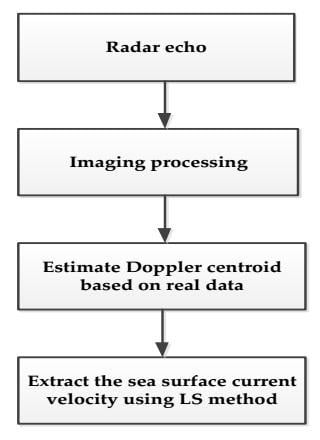Sea Surface Current Estimation Using Airborne Circular Scanning SAR with a Medium Grazing Angle
Abstract
:1. Introduction
2. Operational Mode of Airborne Circular Scanning SAR
3. Estimation of the Sea Surface Current Velocity
3.1. Ideal Model of the Doppler Shift
3.1.1. Doppler Shift of the Sea Surface Current
3.1.2. Doppler Shift of Phase Velocity of Bragg Resonant Waves
3.1.3. Doppler Shift of the Orbital Motions of the Long Waves
3.1.4. Doppler Shift of the Platform Motion
3.2. Practical Model of the Doppler Centroid Shift
- (1)
- When estimating the Doppler centroid shift by applying the clutter lock method based on the energy gravity center of the Doppler spectrum of the real data [35], there exists an estimation error of the Doppler centroid shift, and the estimated Doppler centroid shift can be represented as .
- (2)
- When compensating the platform motion according to Equation (10) for all slant range cells in the same wave beam, there will exist a compensation error which contains the compensation error of the incidence angle departing from the central slant range and the residual compensation error induced by the azimuth pointing error .
3.2.1. Compensation Error of the Incidence Angle
3.2.2. Doppler Shift of Azimuth Pointing Error
3.3. Estimation of Sea Surface Current Velocity
| Algorithm: The sea surface current estimation. |
| Input: Radar echo data Output: Ux, Uy, Δθ. For n = 1: N Process imaging and transform the data into the range Doppler domain. for m = 1:L Compute the Doppler centroid shift of every range cell |
| after the motion compensation. end for Compute the mean Doppler shift as follows: |
| end for Calculate Ux, Uy, Δθ according to the LS method as follows: |
4. Experimental Results and Analyses
4.1. Circular Scanning SAR Data
4.2. Analyses of the Sea Surface Current Velocity Estimation
5. Conclusions
Acknowledgments
Author Contributions
Conflicts of Interest
References
- Chen, C.; Shiotani, S.; Sasa, K. Effect of ocean currents on ship navigation in the East China Sea. Ocean Eng. 2015, 104, 283–293. [Google Scholar] [CrossRef]
- Trizna, D. A model for Doppler peak spectral shift for low grazing angle sea scatter. IEEE J. Ocean. Eng. 1985, 10, 368–375. [Google Scholar] [CrossRef]
- Xin, Z.; Liao, G.; Yang, Z.; Zhang, Y.; Dang, H. A deterministic sea clutter space time model based on physical sea surface. IEEE Trans. Geosci. Remote Sens. 2016, 54, 6659–6673. [Google Scholar] [CrossRef]
- Kim, D.; Moon, W.M.; Imel, D.A.; Moller, D. Remote sensing of ocean waves and currents using NASA (JPL) AIRSAR Along-Track Interferometry (ATI). In Proceedings of the IEEE International Geoscience and Remote Sensing Symposium (IGARSS), Toronto, ON, Canada, 24–28 June 2002; pp. 931–933. [Google Scholar] [CrossRef]
- Thompson, D.R.; Graber, H.C.; Carande, R.E. Measurements of ocean currents with SAR Interferometry and HF Radar. In Proceedings of the IEEE International Geoscience and Remote Sensing Symposium (IGARSS), Pasadena, CA, USA, 8–12 August 1994; pp. 2020–2022. [Google Scholar] [CrossRef]
- Martin, R.J.; Kearney, M.J. Remote sea current sensing using HF Radar: An autoregressive approach. IEEE J. Ocean. Eng. 1997, 22, 151–155. [Google Scholar] [CrossRef]
- Zhang, J.; Walsh, J.; Gill, E.W. Inherent limitations in high-frequency radar remote sensing based on Bragg scattering from the ocean surface. IEEE J. Ocean. Eng. 2012, 37, 395–405. [Google Scholar] [CrossRef]
- Chang, G.; Li, M.; Xie, J.; Zhang, L.; Yu, C.; Ji, Y. Ocean surface current measurement using shipborne HF radar: Model and analysis. IEEE J. Ocean. Eng. 2016, 41, 970–981. [Google Scholar] [CrossRef]
- Chapron, B.; Collard, F.; Ardhuin, F. Direct measurements of ocean surface velocity from space: Interpretation and validation. J. Geophys. Res. Oceans 2005, 110, 691–706. [Google Scholar] [CrossRef]
- Braun, N.; Ziemer, F.; Bezuglov, A.; Cysewski, M.; Schymura, G. Sea surface current features observed by Doppler radar. IEEE Trans. Geosci. Remote Sens. 2008, 46, 1125–1133. [Google Scholar] [CrossRef]
- Rossi, R.; Runge, H.; Breit, H.; Fritz, T. Surface current retrieval from Terrasar-X data using Doppler measurements. In Proceedings of the IEEE 5th Asia-Pacific Conference on Synthetic Aperture Radar (APSAR), Honolulu, HI, USA, 25–30 July 2010; pp. 3055–3058. [Google Scholar] [CrossRef]
- Hansen, M.W.; Collard, F.; Dagestad, K.F.; Johannessen, J.A.; Fabry, P.; Chapron, B. Retrieval of sea surface range velocities from Envisat ASAR Doppler centroid measurements. IEEE Trans. Geosci. Remote Sens. 2011, 49, 3582–3591. [Google Scholar] [CrossRef]
- Kang, K.; Kim, D. Retrieval of sea surface velocity during tropical cyclones from RADARSAT-1 ScanSAR Doppler centroid measurement. In Proceedings of the IEEE 5th Asia-Pacific Conference on Synthetic Aperture Radar (APSAR), Singapore, 1–4 September 2015; pp. 610–613. [Google Scholar] [CrossRef]
- Trizna, D.B. Coherent marine radar measurements of ocean surface currents and directional wave spectra. In Proceedings of the 2011 IEEE Oceans, Santander, Spain, 6–9 June 2011; pp. 1–5. [Google Scholar] [CrossRef]
- Carrasco, R.; Horstmann, J.; Seemann, J. Significant wave height measured by coherent x-band radar. IEEE Trans. Geosci. Remote Sens. 2017, 55, 5355–5365. [Google Scholar] [CrossRef]
- Senet, C.; Seemann, M.J.; Flampouris, S.; Ziemer, F. Determination of bathymetric and current maps by the method DiSC based on the analysis of nautical X-band radar image sequences of the sea surface. IEEE Trans. Geosci. Remote Sens. 2007, 46, 2267–2279. [Google Scholar] [CrossRef]
- Ludeno, G.; Reale, F.; Dentale, F.; Carratelli, P.E.; Natale, A.; Soldovieri, F.; Serafino, F. An X-Band radar system for bathymetry and wave field analysis in harbor area. Sensors 2015, 15, 1691–1707. [Google Scholar] [CrossRef] [PubMed]
- Shen, C.X.; Huang, W.M.; Gill, E.W. An alternative method for surface current extraction from X-band marine radar images. In Proceedings of the IEEE International Geoscience and Remote Sensing Symposium (IGARSS), Quebec City, QC, Canada, 13–18 July 2014; pp. 4370–4373. [Google Scholar] [CrossRef]
- Romeiser, R.; Thompson, D.R. Numerical study on the along-track interferometric radar imaging mechanism of oceanic surface currents. IEEE Trans. Geosci. Remote Sens. 2000, 38, 446–458. [Google Scholar] [CrossRef]
- Suchandt, S.; Runge, H. Ocean surface observations using the TanDEM-X satellite formation. IEEE J. Sel. Top. Appl. Earth Obs. Remote Sens. 2015, 8, 5096–5105. [Google Scholar] [CrossRef]
- Kim, D.; Moon, W.M. Investigation of ocean waves and currents with PacRim along-track interferometry (ATI). In Proceedings of the IEEE International Geoscience and Remote Sensing Symposium (IGARSS), Sydney, Australia, 9–13 July 2001; pp. 1415–1417. [Google Scholar] [CrossRef]
- Romeiser, R.; Runge, H.; Suchandt, S.; Kahle, R.; Rossi, C.; Bell, P.S. Quality assessment of surface current fields from TerraSAR-X and TanDEM-X along-track interferometry and Doppler centroid analysis. IEEE Trans. Geosci. Remote Sens. 2014, 52, 2759–2772. [Google Scholar] [CrossRef]
- Toporkov, J.V.; Perkovic, D.; Farquharson, G.; Sletten, M.A.; Frasier, S.J. Sea surface velocity vector retrieval using dual-beam interferometry: First demonstration. IEEE Trans. Geosci. Remote Sens. 2005, 43, 2494–2502. [Google Scholar] [CrossRef]
- Frasier, S.J.; Camps, A.J. Dual-beam interferometry for ocean surface current vector mapping. IEEE Trans. Geosci. Remote Sens. 2001, 39, 401–414. [Google Scholar] [CrossRef]
- Kim, D.; Moon, W.M.; Moller, D.; Imel, D.A. Measurements of ocean surface waves and currents using L- and C-Band along-track interferometric SAR. IEEE Trans. Geosci. Remote Sens. 2003, 41, 2821–2832. [Google Scholar] [CrossRef]
- Bao, Q.; Dong, X.; Zhu, D.; Lang, S.; Xu, X. The feasibility of ocean surface current measurement using pencil-beam rotating scatterometer. IEEE J. Sel. Top. Appl. Earth Obs. Remote Sens. 2015, 8, 3441–3451. [Google Scholar] [CrossRef]
- An, C.; He, X.; Chen, Z. Theoretical Analysis of circular-scanning SAR based on resolution and imaging efficiency comparison. In Proceedings of the 2010 2nd International Workshop on Intelligent Systems and Applications (ISA), Wuhan, China, 22–23 May 2010; pp. 1–4. [Google Scholar] [CrossRef]
- Xin, Z.; Liao, G.; Yang, Z. Estimation of current velocity using circular SAR data. Electron. Lett. 2016, 52, 1482–1484. [Google Scholar] [CrossRef]
- Plant, W.J.; Keller, W.C. Evidence of Bragg scattering in microwave Doppler spectra of sea return. J. Geophys. Res. Oceans 1990, 95, 16299–16310. [Google Scholar] [CrossRef]
- Zapevalov, A.S. Bragg scattering of centimeter electromagnetic radiation from the sea surface: The effect of waves longer than Bragg components. Izv. Atmos. Ocean. Phys. 2009, 45, 253–261. [Google Scholar] [CrossRef]
- Holthuijsen, L.H. Waves in Ocean and Coastal Waters; Cambridge University Press: Cambridge, UK, 2007. [Google Scholar]
- Li, X. Ocean Surface Wave Measurement Using SAR Wave Mode Data. Ph.D. Thesis, University Hamburg, Hamburg, Germany, 2010. [Google Scholar]
- Rheem, C.K. Measurement of directional spectrum of sea surface waves by using a microwave pulse Doppler radar with two fixed antennas. In Proceedings of the 2011 Oceans, Waikoloa, HI, USA, 19–22 September 2011; pp. 1–6. [Google Scholar] [CrossRef]
- Durden, S.; Vesescky, J. A physical radar cross-section model for a wind driven sea with swell. IEEE J. Ocean. Eng. 1985, 10, 445–451. [Google Scholar] [CrossRef]
- Wang, Y.L.; Yan, L.; Wang, Y.K. Improved Algorithm of Doppler centroid estimation for air-borne synthetic aperture radar. Acta Geod. Cartogr. Sin. 2010, 39, 271–275. [Google Scholar]
- Watts, S.; Rosenberg, L.; Bocquet, S.; Ritchie, M. Doppler spectra of medium grazing angle sea clutter part 2: Model assessment and simulation. IET Radar Sonar Navig. 2016, 10, 32–42. [Google Scholar] [CrossRef]
- Polverari, F.; Mori, S.; Pierdicca, N.; Marzano, F.S. Precipitation signature on side-looking aperture radar imaging: Sensitivity analysis to surface effects at C, X and Ku band. In Proceedings of the European Radar Conference (EuRAD), Rome, Italy, 8–10 October 2014; pp. 197–200. [Google Scholar] [CrossRef]
- Song, D.; Shang, S.; Luo, X. The study of microwave scattering of anisotropic sea surface with the corrected two-scale model. In Proceedings of the European Radar Conference (EuRAD), Paris, France, 9–11 September 2015; pp. 545–547. [Google Scholar] [CrossRef]
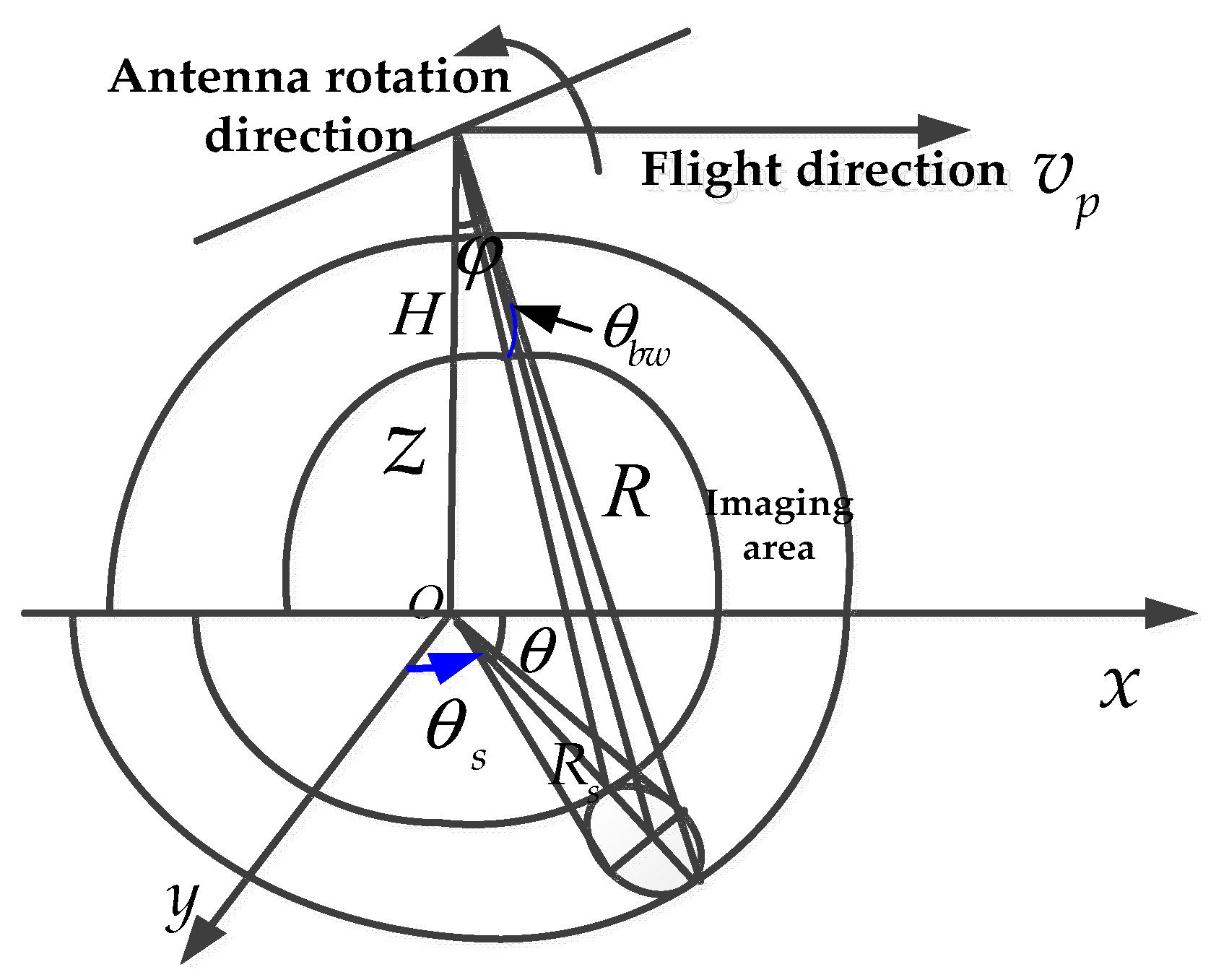
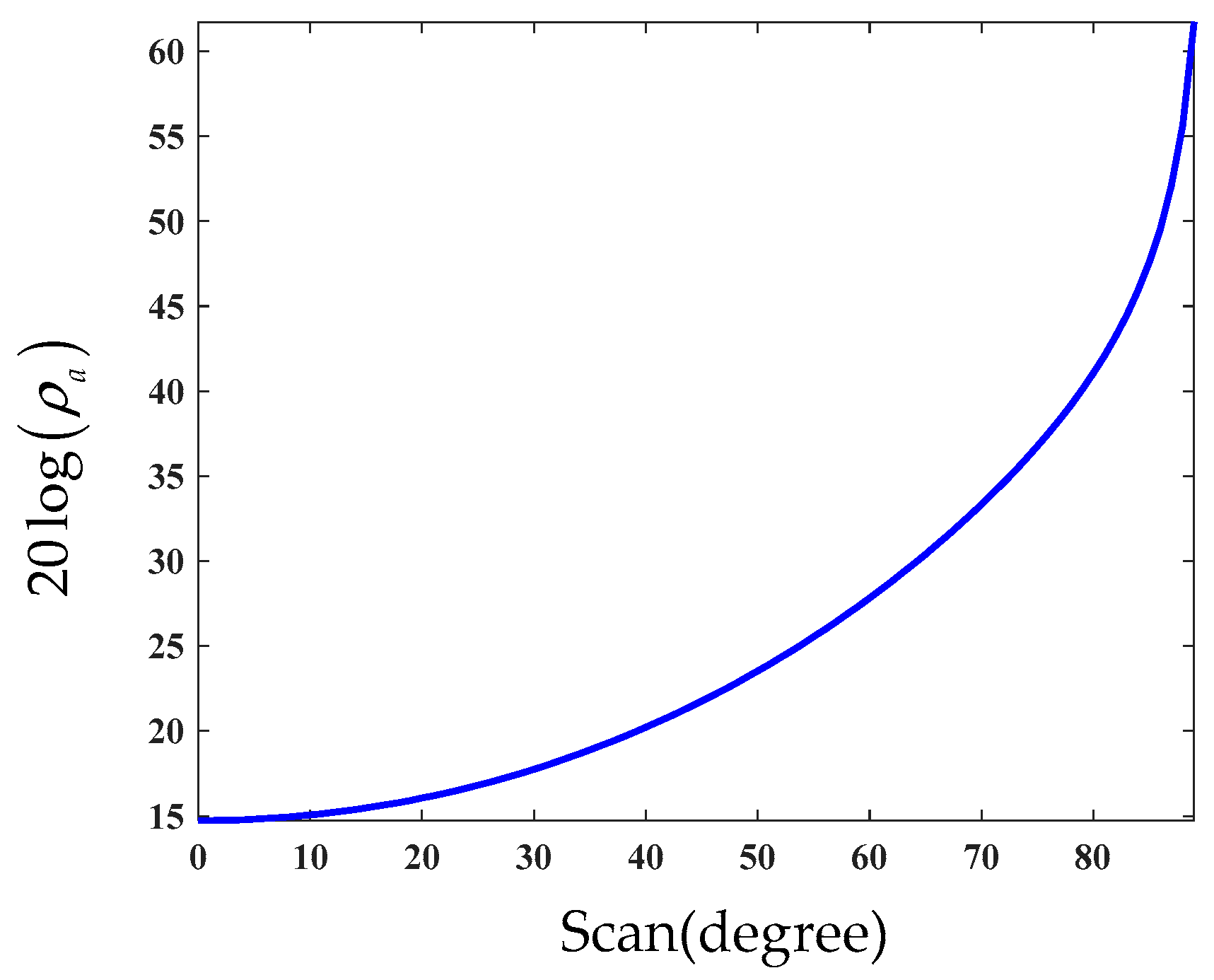
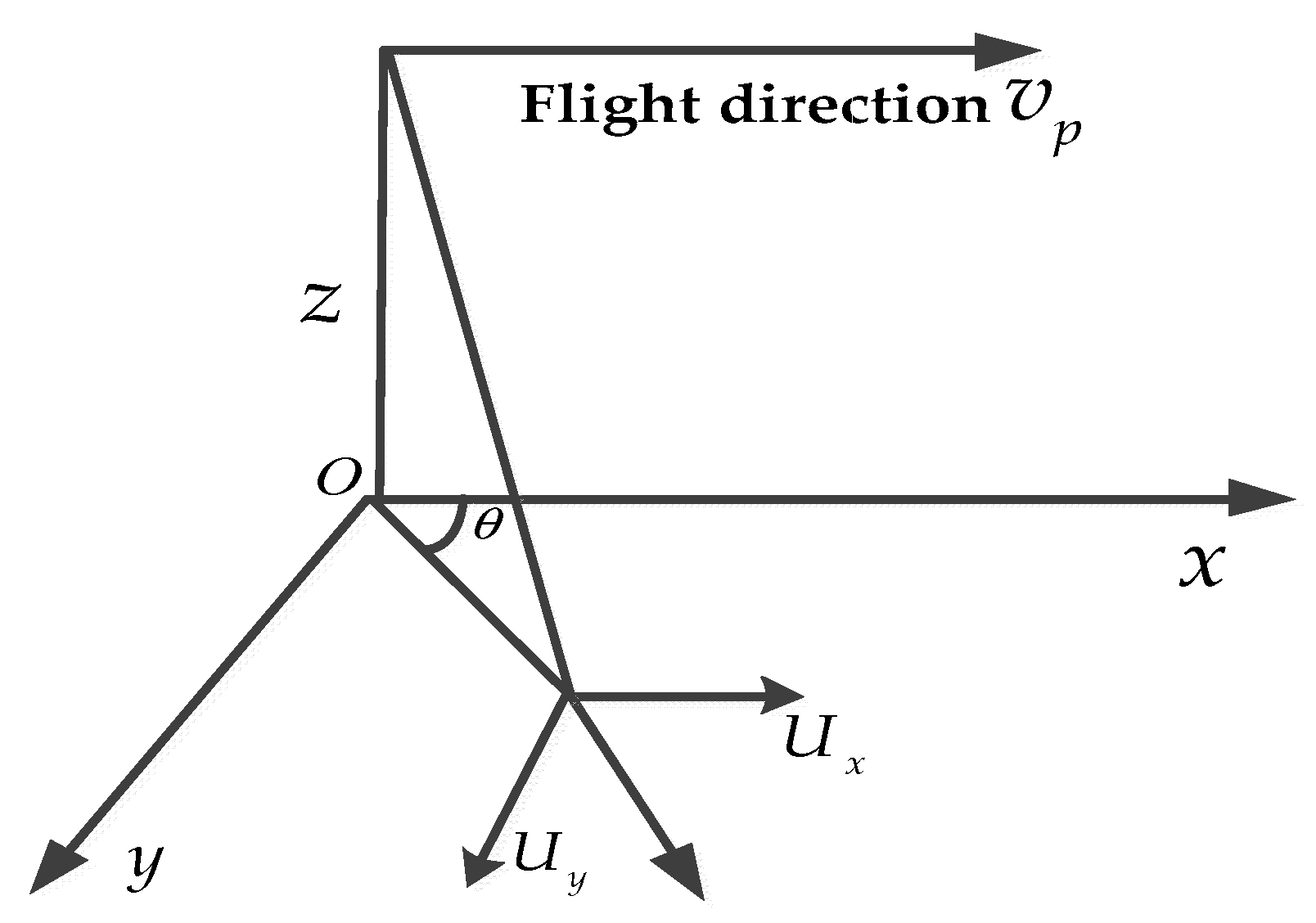


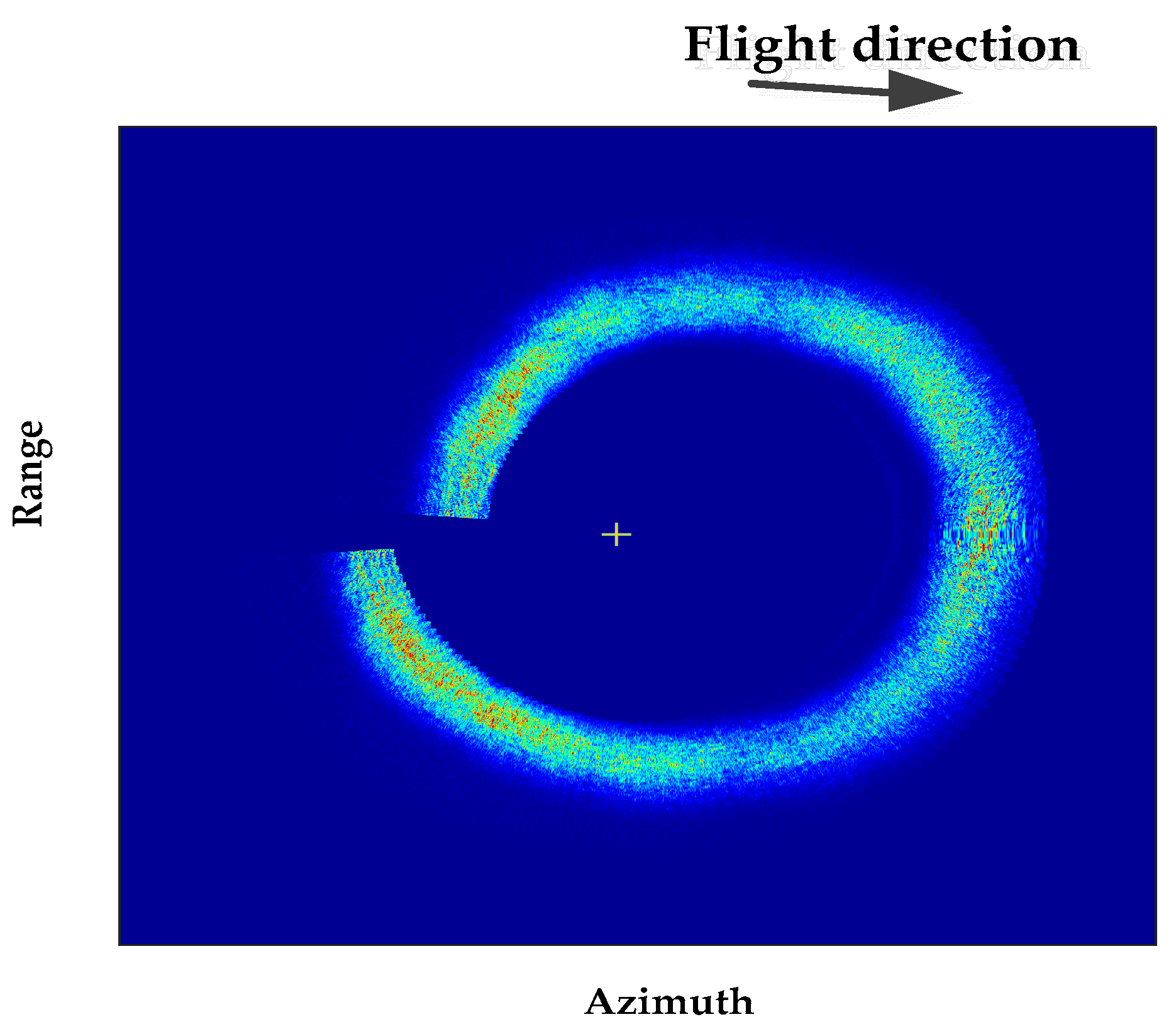
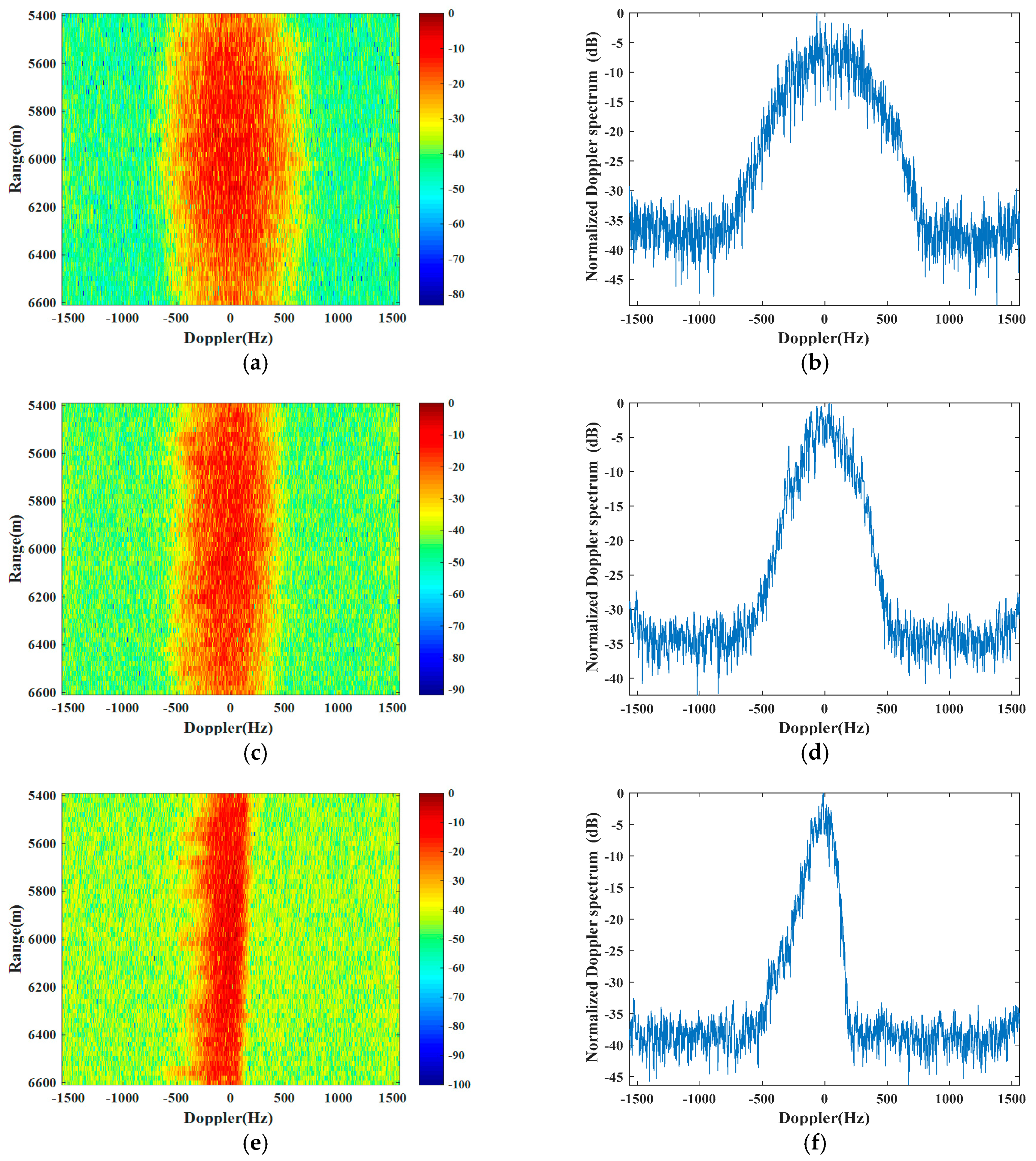
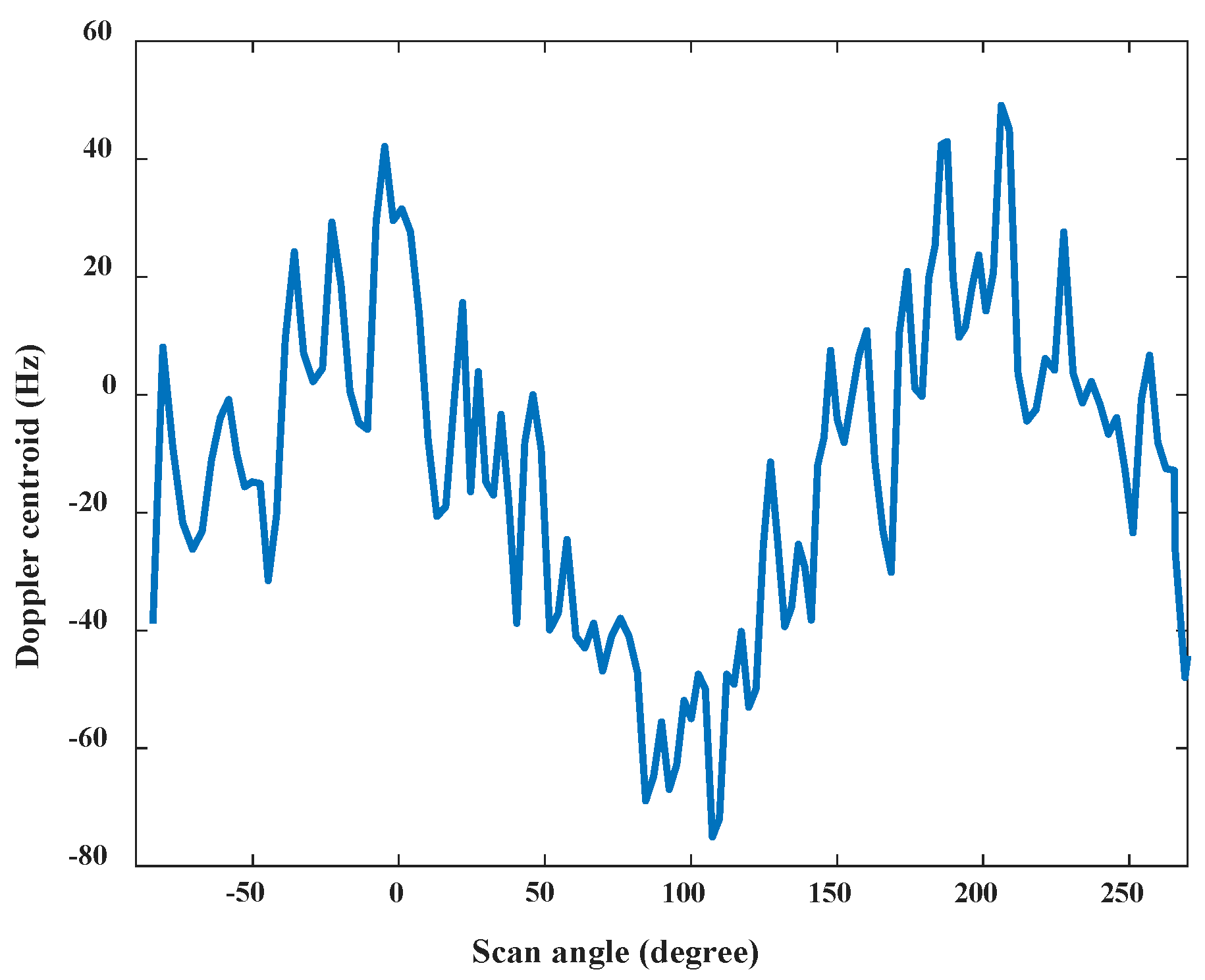
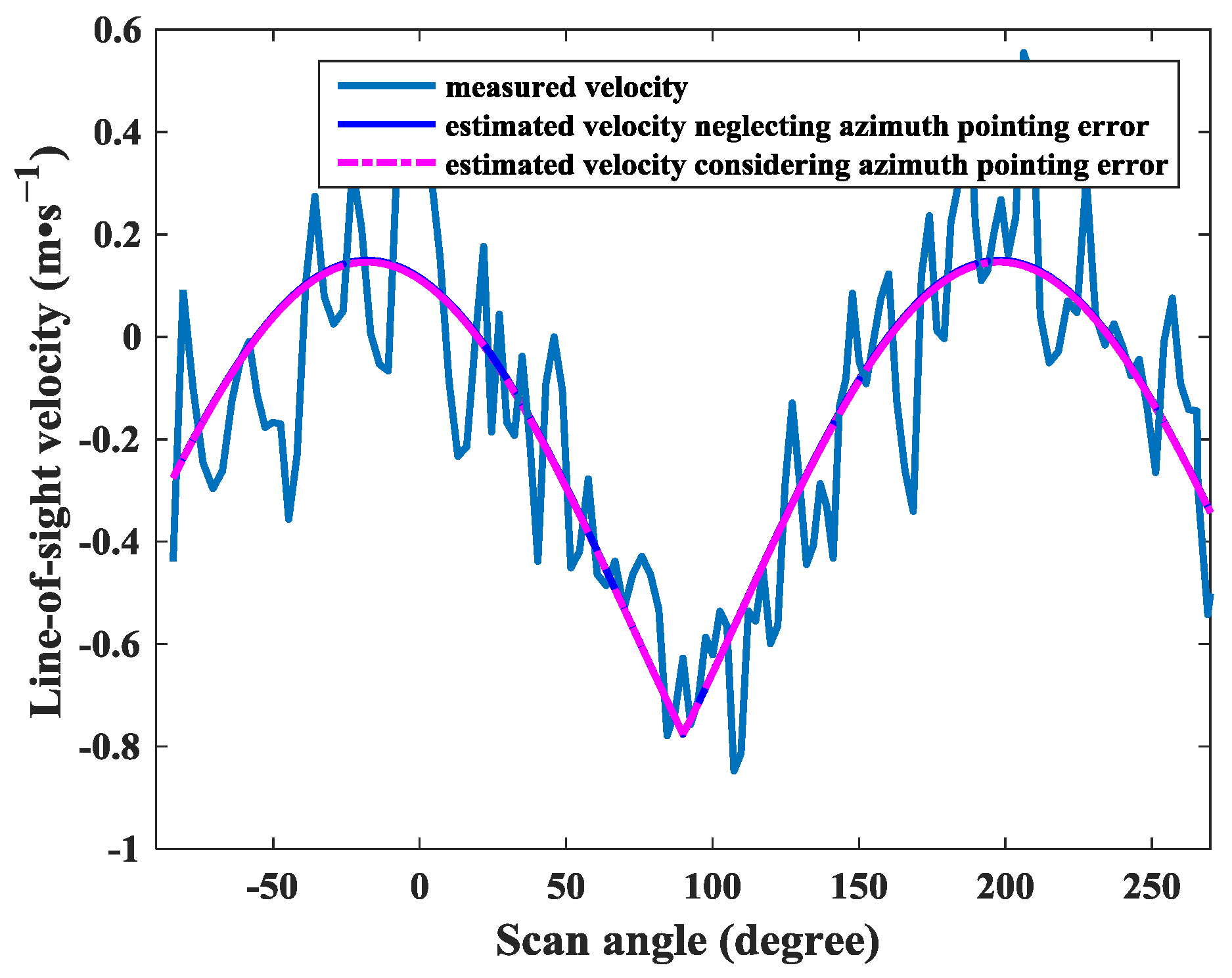
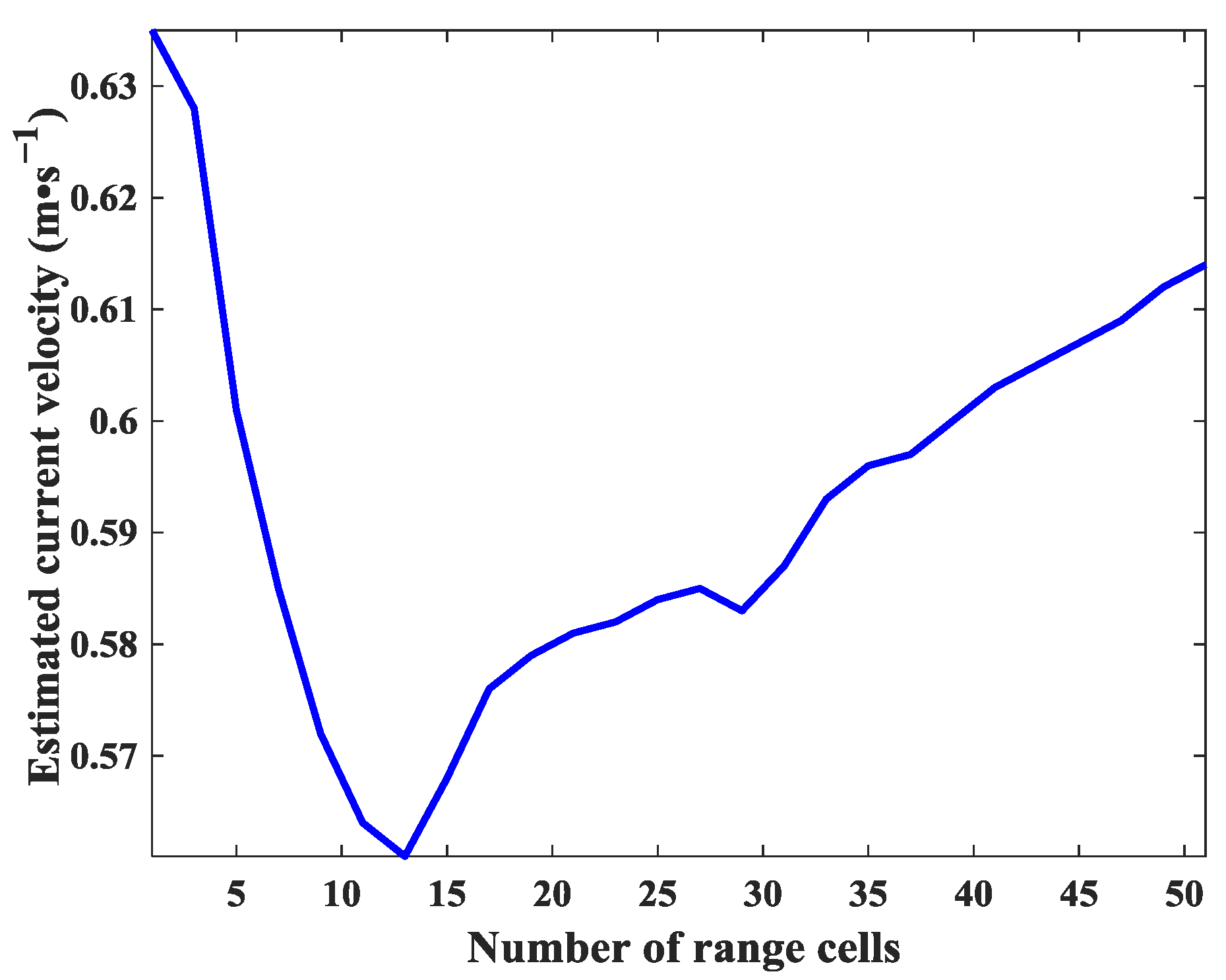
| Parameters | Values |
|---|---|
| Antenna beam width(azimuth/pitch) | 6.2/6.4 degree |
| Rader frequency | 13 GHz |
| Range resolution | 20 m |
| Platform speed | 130 m·s−1 |
| Platform flight height | 3000 m |
| Antenna scanning rate | 30 degrees·s−1 |
| Pulse repetition frequency (PRF) | 3000 Hz |
| Grazing angle of beam center | 35 degree |
| Wind speed | 7.8 m·s−1 |
| Sea state | 3 level |
| Significant wave height | 2.0 m |
| Polarization | HH |
© 2018 by the authors. Licensee MDPI, Basel, Switzerland. This article is an open access article distributed under the terms and conditions of the Creative Commons Attribution (CC BY) license (http://creativecommons.org/licenses/by/4.0/).
Share and Cite
Pan, X.; Liao, G.; Yang, Z.; Dang, H. Sea Surface Current Estimation Using Airborne Circular Scanning SAR with a Medium Grazing Angle. Remote Sens. 2018, 10, 178. https://doi.org/10.3390/rs10020178
Pan X, Liao G, Yang Z, Dang H. Sea Surface Current Estimation Using Airborne Circular Scanning SAR with a Medium Grazing Angle. Remote Sensing. 2018; 10(2):178. https://doi.org/10.3390/rs10020178
Chicago/Turabian StylePan, Xueli, Guisheng Liao, Zhiwei Yang, and Hongxing Dang. 2018. "Sea Surface Current Estimation Using Airborne Circular Scanning SAR with a Medium Grazing Angle" Remote Sensing 10, no. 2: 178. https://doi.org/10.3390/rs10020178




